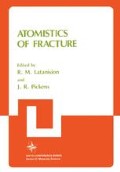Abstract
At low partial pressures of hydrogen (less than 0.1 MPa), hydrogen interacts with the metal and lowers the cohesive strength of the lattice (Oriani and Josephic, 1977). The decohesion theory postulates that regions exist near the crack tip with hydrogen concentrations, which are several orders of magnitude larger than the lattice concentration of hydrogen. The microstructure strongly influences the embrittlement process and the crack growth kinetics. (Kumnick and Johnson, 1980). Thus it can be expected, that the experimental study of the mechanism of gaseous hydrogen embrittlement is facilitated by studying the process at the crack tip in its simplest form under the most simple boundary conditions. For these reasons FeSi-single crystals are used, since the micro-processes for ductile and brittle fracture are well known in this alloy (Vehoff and Neumann, 1979, 1980). Tests are carried out at different temperatures, hydrogen pressures and plastic crack tip opening rates in order to investigate the influence of the hydrogen concentration at the crack tip on the brittleness of the fracture process (Wei and co-workers, 1980).
Access this chapter
Tax calculation will be finalised at checkout
Purchases are for personal use only
Preview
Unable to display preview. Download preview PDF.
References
Boszo, F., G. Ertl, M. Grunze, and M. Weiss (1977). Appl. Surf. Sci., 1: 103.
Clark, A. (1970). in: The Theory of Adsorption and Catalysis, Academic Press, New York, Chap. 9: 209.
Hirth, J.P., and B. Carnahan (1978). Acta Metall., 26: 1795.
Kumnick, A.J., and H.H. Johnson (1980). Acta Metall., 28: 33.
Oriani, R.:., and P.H. Josephic (1977). Acta Metall., 25: 979.
Vehoff, H., and P. Neumann (1979). Acta Metall., 27: 915.
Vehoff, H., and P. Neumann (1980). Acta Metall., 28: 265.
Vehoff, H., W. Rothe, and P. Neumann (1981), Fracture Research, Vol. 1, ICF5, 265.
Wei, R.P., P.S. Pao, R.G. Hart, T.W. Weir and G.W. Simmons (1980). Met.Trans.A., Vol. 11A: 151.
Author information
Authors and Affiliations
Editor information
Editors and Affiliations
Rights and permissions
Copyright information
© 1983 Plenum Press, New York
About this chapter
Cite this chapter
Vehoff, H., Rothe, W., Neumann, P. (1983). Hydrogen Assisted Crack Growth in High Purity Low Pressure Hydrogen Gas. In: Latanision, R.M., Pickens, J.R. (eds) Atomistics of Fracture. Springer, Boston, MA. https://doi.org/10.1007/978-1-4613-3500-9_32
Download citation
DOI: https://doi.org/10.1007/978-1-4613-3500-9_32
Publisher Name: Springer, Boston, MA
Print ISBN: 978-1-4613-3502-3
Online ISBN: 978-1-4613-3500-9
eBook Packages: Springer Book Archive

